 INTERVIEW
INTERVIEW
As one half of the first costuming team I ever noticed as a young movie fanatic, interviewing JENNY BEAVAN was a special treat. She's currently enjoying her ninth Oscar nomination for her work on The King's Speech. This is her third solo nomination. She and her former partner John Bright costumed the Ishmael Merchant & James Ivory period dramas that I grew up obsessing over: A Room With A View, Howard's End, Maurice and the like. When Jenny and I spoke to discuss her current Oscar run for The King's Speech, however, it was less period drama and more modern comedy. "I'm guessing as to what you're saying" she told me while technical difficulties had us both comically shouting into our phones / computers until the situation was resolved.
We began at the beginning.
Merchant/Ivory is after all, a very good place to start, both for a young film buff in the 80s and a costume designer embarking on a huge career in the movies. "That was my start in the whole thing," Beavan recalled, noting that the films were great fun to do.
The Merchant & Ivory Days
John Bright's name was peppered throughout her conversation. In fact, she had just seen him earlier that day. I had long wondered why they stopped working together. "We were known as Jenny Bright and John Beavan," she says about their close partnership. "I mean, he is just one of my absolutely best friends and also my most important collaborator. Believe me we're still collaborating. Just not so officially."
As it turns out Bright owns and runs Cosprop, a hugely important costume house which specializes in period wear, an enormous job in and of itself though he still does the odd film. I mention how much I love his work on the ravishing The White Countess (2005) with elicits a barrage of superlatives from Beavan. "Absolutely brilliant!"
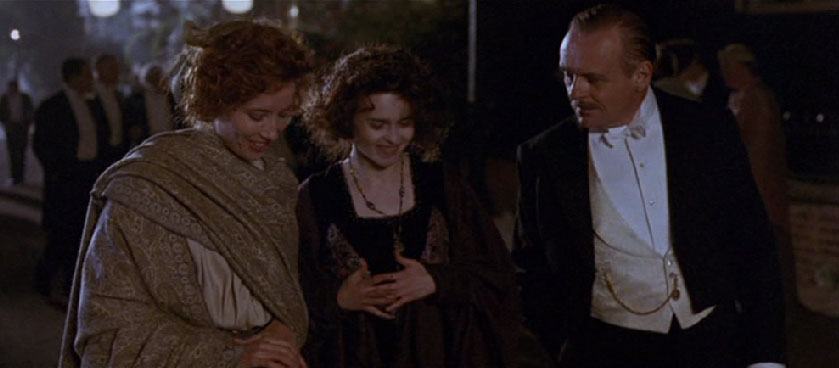 Howards End (1992), a masterpiece.
Howards End (1992), a masterpiece.
We discuss a particular moment in Howards End that I'm very fond of. The Schlegel sisters (Emma Thompson and Helena Bonham-Carter) walking home one evening run into Mr Wilcox (Anthony Hopkins). One can't get enough of the beauty of that movie. The clothes are so modest but there's such sensuality to them and something so resonant and bohemian about the sisters. Beavan credits the screenplay with the specificity that makes character costuming easier and the actresses with the film's modernity.
Beavan, having logged a lot of time in costume dramas, thinks there's real power with staying utterly within period. If you step away from the period, she explains "it looks wrong and then you get a sort of worry in the audience." Producers, particularly the America ones, she shares, don't like to see hats in the movies. And sometimes you just have to use hats. "Everybody wore hats up until the 1950s in England!" she says with feigned exasperation.
My grandmother would never go out without a hat on. She wouldn't have felt dressed.
After the golden period of the Merchant/Ivory films, Beavan's official partnership with John Bright ended and the designer got a chance to "fly a bit more my own." That's what one might call an understatement.
READ THE REST for thoughts on Helena Bonham Carter's style, "finding" Sherlock Holmes and more.
She's been soaring. Her work in the past fifteen years includes mainstream fables like Ever After (1998), modern classics like Gosford Park (2001), eye candy like Casanova (2005), blockbusters like Sherlock Holmes (2009) and Oscar powerhouses like The King's Speech (2010) among many others.
The King's Speech & The Queen Mum's Wardrobe
Is it less fun to do subtle costume work like The King's Speech than a showy effort? Beavan doesn't make a distinction between the two.
"The thing is i never approach a project other than from the point of view of the characters and the storytelling. And in The King's Speech we're talking obviously about people who really existed and yet they're played by people who don't necessarily look like them so we're trying to find a compromise, a way to find the spirit of the real person."
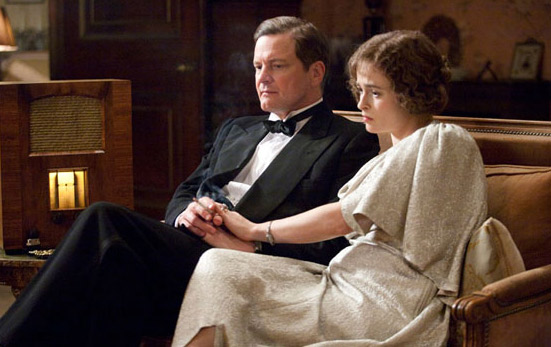 Colin and Helena as the King and Queen
Colin and Helena as the King and Queen
"Particularly with someone like Helena Bonham Carter playing the Queen Mother who we know wore quite sharp pastel colors." she says by way of example. "Actually if you do that on Helena you're just creating a costume whereas if you actually soften it, you're creating the spirit of the real person."
For those of you reading out there who are Project Runway fans, she's one of those brave designers who works right on the form rather than carefully sketching out her designs. She describes her process as instinctual, and though she's done her research and prepared ideas, the magic happens in the fitting.
"I don't really predict what's going to happen," she says. "I have ideas and staff and clothes and swatches of fabric and what have you but it's always about dressing someone up and seeing and knowing when you hit the truth of whatever that character is in that play or film. It's when you dress an actor up that you know whether it's working or not. When it's not working, that's often as useful to you, to learn why it's not, as when it is working."
She's worked with Helena Bonham-Carter four times now and I wonder if it's helpful to know an actor well. A bit, she admits, but mostly the difference is in the fun. "You can have a laugh from the moment they walk in the door." Helena's name pops up so often in our conversation that the subject of Helena's own unique fashion sense creeps into the conversation. Now it's Beavan and I who are suddenly having a laugh.
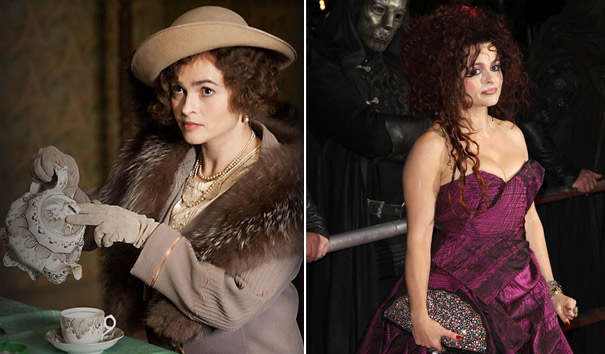
"Oh my god. She has the most fantastic style which I envy. But I'm slightly too old and definitely too fat to do it. But she's fabulous!"
But, given Helena's distinct style, does that ever bleed into her reaction to her costumes?
"Luckily she would understand that her style is not entirely appropriate to the woman who became the queen mother." Beaven adds, humoring the question. "But she did have the most marvelous pair of gold shoes from the late 20s/ early 30s that had belonged to her grandmother which she certainly wore and she wears in the last sequence.
Icons: Alexander (2004) and Sherlock Holmes (2009)
With three decades of cinematic designs behind her, which of her films did she find the most challenging? Beavan doesn't have to think for more than a moment before answering.
"Alexander. For many reasons. I took over at quite the last minute on that," she says detailing the difficulties of a short prep time and laughing about her own ignorance of Alexander and the Classical era and the difficulties of instantaneous research before the age of Google.
"Thank god for the vases in the British museum and the amount of information they can impart!"
She and her team had to create every single stitch of clothing and armor, and a massive amount of both. You can't exactly head to the thrift shop to find robes from 330 B.C. Beavan cautions that you can't go too literal with costume design, even if you do know everything about an era. You have be "truthful but also filmic."
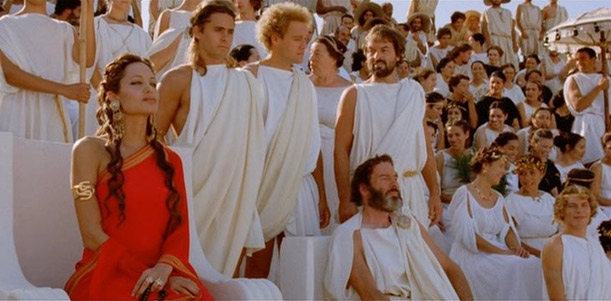 Angelina Jolie in red, cast in white in Alexander (2004)
Angelina Jolie in red, cast in white in Alexander (2004)
Do bold color strokes like the one that puts Angelina's bold red in a sea of white make her nervous as a designer? "All the time," she admits matter-of-factly, bringing us to the here and now and her work on the Sherlock Holmes franchise. "I was nervous just this morning before we did a sequence with Robert Downey Jr. I'm nervous on a daily basis about how it's going to work."
The modern movie marketing technique of character posters has become something of an advertisement for the craft of costume design. Her work was definitely on display before we even saw Sherlock Holmes (2009). She hadn't thought of it like that, the teaser posters doubling as fashion spreads, but definitely felt the pressure.
"They were looking for a different Sherlock image. I had to find that for them," she says noting the enormous amount of people who had to approve things the first time around. "Whereas something like The King's Speech is all about people who existed and trying to recreate a feeling of familiarity with an age. Nobody wanted an iconic new looking George VI."
Heh.
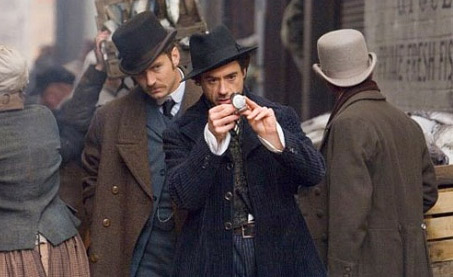 Revisualizing Sherlock Holmes and Dr Watson in 2009
Revisualizing Sherlock Holmes and Dr Watson in 2009
She has nothing but praise for Warner Bros handling of both films though and says that they provide "very reasonable but not stupid and excessive" budgets. When she's working on something like The King's Speech or Black Dahlia (2006) her job gets very hands on, she's out there buying the stockings herself. But Sherlock Holmes is a whole different ballgame. She's "blooming good at delegating" which comes in handy on the blockbusters. On the big budget projects she'll do an initial "pull" on crowd costumes, for example, with whoever is assigned to the crowd and extras so they'll know what she's looking for so she can focus on the principals.
She's only one done one sequel prior to Sherlock Holmes, Return to Cranford with Judi Dench which she calls "television at its most sublime." She recognizes the absurdity of listing them together as sequel challenges, since Cranford is so much simpler.
"There's no question about whether they'll have something new to wear. Two years later of course they won't! In Victorian England people kept dresses for years!"
"In a way we're trying to keep it the same and move it foreword." she says contemplating the challenge of the Untitled Sherlock Holmes Sequel. "But the story does take it into completely different worlds. What happens to them dictates a huge amount of what they wear. For instance, they pack a case and then don't take it means they're stuck in what they're wearing and they have to find clothes. In a way storylines make my job easier and sometimes make it more difficult. I'll leave it to you to see what i mean."
No spoilers are escaping Jenny Beavan.
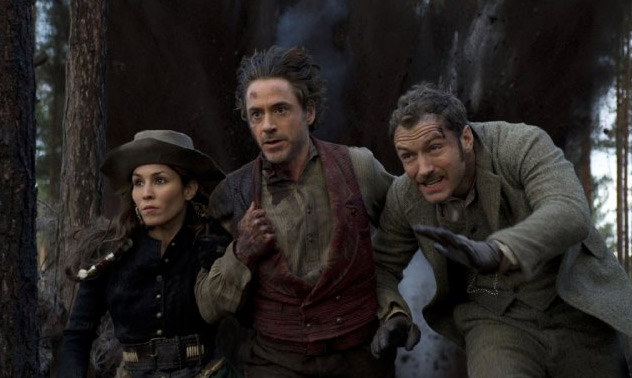 Noomi Rapace, Robert Downey Jr, and Jude Law in the Sherlock Holmes Sequel
Noomi Rapace, Robert Downey Jr, and Jude Law in the Sherlock Holmes Sequel
A Costume Designers Work is Never Done
With the knowledge that she's nearing the end of the Sherlock shoot, I confessed my ignorance about what a costume designers job would entail once all the looks have been chosen, created, or assigned to specific scenes and characters.
"Ah, but you haven't done the film." she says eager to enlighten. "In theater you work toward the first night and normally that's the end of your job. In film it's a completely ongoing thing. If it's like a ten week shoot and some character comes in for only the last week of the schedule they might not even be cast until week nine. Often, especially with things like Sherlock Holmes, we improvise a lot. We are continuously, with every new sequence as a collaborative team, thinking of something new which often impacts on me quite heavily."
Even into week twelve of Sherlock Homes i'm still designing.
Winning the Gold.
Before we ended our delightful conversation, I asked the talented designer if she had any specific memories of her Oscar winning night in 1987 when she and John Bright won Best Costume Design for A Room With a View. As it turns out someone had just sent her a picture of that very night and she was looking at Bright, herself and Lauren Bacall as she and I were talking. "We are all terribly young, not bad looking!"
"I remember being so overhyped that if we hadn't got it I think we would have been rather surprised. So we prepared the speech. We did the whole handover. We had 45 seconds so we timed it perfectly. I remember sort of floating up there. And then this incredibly heavy thing being handed to me which was just as well because it was quite grounding."
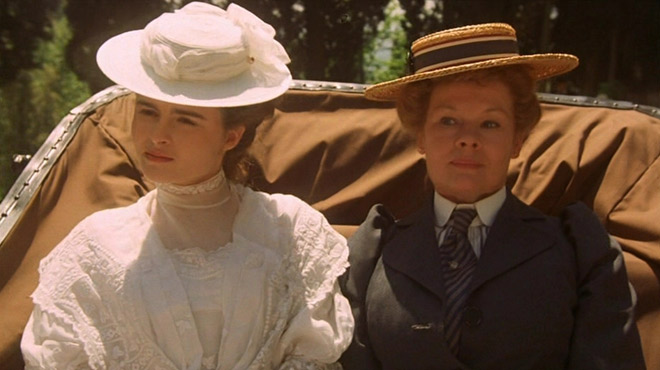 Oscar winning costumes modelled by Helena Bonham-Carter and Judi Dench
Oscar winning costumes modelled by Helena Bonham-Carter and Judi Dench
The finale of her story had me in stitches.
I remember going backstage and thinking 'Oh my god!' . And they said 'Would you like a drink?' 'Oh i'd love a drink!' [Affects American accent] 'Would you like a diet coke or…?' [Her own voice] 'NO! Not a Diet Coke. I WANT A BLOODY CHAMPAGNE!'
She may need another champagne come Oscar night 2011. Have it at the ready backstage.
